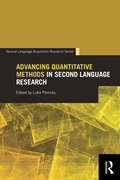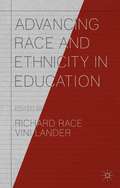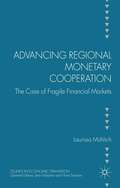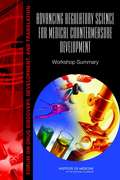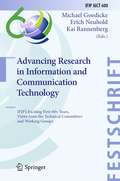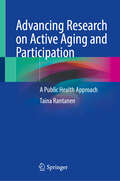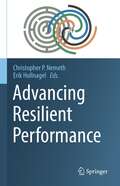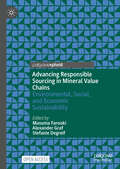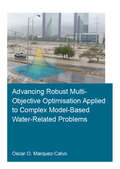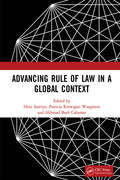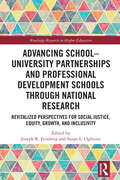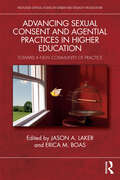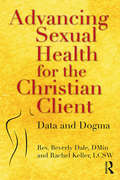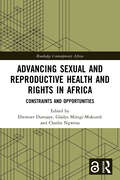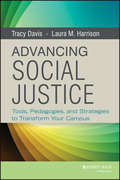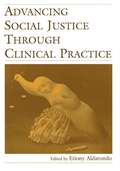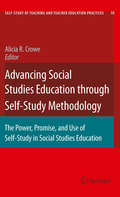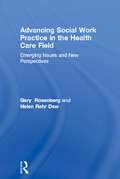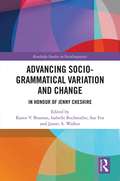- Table View
- List View
Advancing Quantitative Methods in Second Language Research (Second Language Acquisition Research Series)
by Luke PlonskyAdvancing Quantitative Methods in Second Language Research is the first hands-on guide to conducting advanced research methods in the fields of applied linguistics and second language studies. While a number of texts discuss basic quantitative research methodology, none focus exclusively on providing coverage of alternative advanced statistical procedures in second language studies from a practical approach. The text is bookended by discussions of these advanced procedures in the larger context of second language studies, debating their strengths, weaknesses, and potential for further research; the remaining chapters are how-to sections, each chapter following the same organization, on a wide variety of advanced research methods. By offering much-needed coverage on advanced statistical concepts and procedures, with an eye toward real-world implementation, Advancing Quantitative Methods in Second Language Research enhances the methodological repertoire of graduate students and researchers in applied linguistics and second language studies. For additional content, visit: http://oak.ucc.nau.edu/ldp3/AQMSLR.html
Advancing Race and Ethnicity in Education
by Vini Lander Richard RaceThis timely collection focuses on domestic and international education research on race and ethnicity. As co-conveners of the British Education Research Associations (BERA) Special Education Group on Race and Ethnicity (2010-2013), Race and Lander are advocates for the promotion of race and ethnicity within education. With its unique structure and organisation of empirical material, this volume collates contributions from global specialists and fresh new voices to bring cutting-edge research and findings to a multi-disciplinary marker which includes education, sociology and political studies. The aim of this book is to promote and advocate a range of contemporary issues related to race, ethnicity and inclusion in relation to pedagogy, teaching and learning.
Advancing Regional Monetary Cooperation: The Case of Fragile Financial Markets (Studies in Economic Transition)
by Laurissa MühlichThis book examines regional monetary cooperation as a strategy to enhance macroeconomic stability in developing countries and emerging markets. Interdisciplinary case studies on Southern Africa, Southeast Asia and South America provide a cross-regional perspective on the viability of such strategy.
Advancing Regulatory Science for Medical Countermeasure Development
by The National Academy of SciencesWhether or not the United States has safe and effective medical countermeasures--such as vaccines, drugs, and diagnostic tools--available for use during a disaster can mean the difference between life and death for many Americans. The Food and Drug Administration (FDA) and the scientific community at large could benefit from improved scientific tools and analytic techniques to undertake the complex scientific evaluation and decision making needed to make essential medical countermeasures available. At the request of FDA, the Institute of Medicine (IOM) held a workshop to examine methods to improve the development, evaluation, approval, and regulation of medical countermeasures. During public health emergencies such as influenza or chemical, biological, radiological/nuclear (CBRN) attacks, safe and effective vaccines, treatments, and other medical countermeasures are essential to protecting national security and the well being of the public. Advancing Regulatory Science for Medical Countermeasure Developmentexamines current medical countermeasures, and investigates the future of research and development in this area. Convened on March 29-30, 2011, this workshop identified regulatory science tools and methods that are available or under development, as well as major gaps in currently available regulatory science tools. Advancing Regulatory Science for Medical Countermeasure Developmentis a valuable resource for federal agencies including the Food and Drug Administration (FDA), the Department of Health and Human Services (HHS), the Department of Defense (DoD), as well as health professionals, and public and private health organizations.
Advancing Research in Information and Communication Technology: IFIP's Exciting First 60+ Years, Views from the Technical Committees and Working Groups (IFIP Advances in Information and Communication Technology #600)
by Erich Neuhold Kai Rannenberg Michael GoedickeFor 60 years the International Federation for Information Processing (IFIP) has been advancing research in Information and Communication Technology (ICT). This book looks into both past experiences and future perspectives using the core of IFIP's competence, its Technical Committees (TCs) and Working Groups (WGs). Soon after IFIP was founded, it established TCs and related WGs to foster the exchange and development of the scientific and technical aspects of information processing. IFIP TCs are as diverse as the different aspects of information processing, but they share the following aims:To establish and maintain liaison with national and international organizations with allied interests and to foster cooperative action, collaborative research, and information exchange.To identify subjects and priorities for research, to stimulate theoretical work on fundamental issues, and to foster fundamental research which will underpin future development.To provide a forum for professionals with a view to promoting the study, collection, exchange, and dissemination of ideas, information, and research findings and thereby to promote the state of the art.To seek and use the most effective ways of disseminating information about IFIP’s work including the organization of conferences, workshops and symposia and the timely production of relevant publications.To have special regard for the needs of developing countries and to seek practicable ways of working with them.To encourage communication and to promote interaction between users, practitioners, and researchers.To foster interdisciplinary work and – in particular – to collaborate with other Technical Committees and Working Groups. The 17 contributions in this book describe the scientific, technical, and further work in TCs and WGs and in many cases also assess the future consequences of the work’s results. These contributions explore the developments of IFIP and the ICT profession now and over the next 60 years. The contributions are arranged per TC and conclude with the chapter on the IFIP code of ethics and conduct.
Advancing Research on Active Aging and Participation: A Public Health Approach
by Taina RantanenThis book covers the central aspects of Advancing Research on Active Aging and Participation, illustrating how individuals can prepare for old age and promote their own well-being. The increase in the aging population has been foreseen for a long time. Traditionally, aging is considered to comprise progressive decline of health and social life, stemming from biased selection of predominantly negative outcomes in studies. However, changes in the life stage of old age have been so rapid that the general perception of growing old has become somewhat outdated. There is an evident need for a multidisciplinary work that describes aging and old age based on the latest knowledge. Dealing with aging in all areas of society should be based on knowledge, not assumptions. This book provides up-to-date information on how aging can be studied and how modern times are reshaping it. Besides, it demonstrates how a more positive approach in aging research will structure the ideas and alleviate the prejudices we have about aging and old age. The book is intended for students and professionals in the social, leisure and health care fields at universities. It can also be adopted for education in the fields of physical education, medicine, and psychology. Additionally, individuals working in the field of health, functional ability, physical activity, rehabilitation, mental health, and well-being of the aging population will benefit from this work.
Advancing Research on Chronic Conditions in Women
by National Academies of Sciences, Engineering, and Medicine Health and Medicine Division Board of Population Health and Public Health Practice Committee on a Framework for the Consideration of Chronic Debilitating Conditions in WomenWomen in the United States experience a higher prevalence of many chronic conditions, including Alzheimer’s disease, depression, and osteoporosis, than men; they also experience female-specific conditions, such as endometriosis and pelvic floor disorders. A lack of research into both the biological and social factors that influence these conditions greatly hinders diagnosis, treatment, and prevention efforts, thus contributing to poorer health outcomes for women and substantial costs to individuals and for society. The National Institutes of Health’s Office of Research on Women’s Health asked the National Academies of Sciences, Engineering, and Medicine to convene an expert committee to identify gaps in the science on chronic conditions that are specific to or predominantly impact women, or affect women differently, and propose a research agenda. The committee’s report presents their conclusions and recommendations.
Advancing Research on Understanding Environmental Effects of UV Filters from Sunscreens: Proceedings Of A Workshop
by Ocean Studies Board Board on Health Sciences Policy Division on Earth and Life Studies Board on Environmental Studies and Toxicology Health and Medicine DivisionSunscreens and a variety of other products contain chemical ultraviolet (UV) filters that absorb or block the sun's radiation and thereby help mitigate harms to human skin from the sun. The 2022 NASEM report Review of Fate, Exposure, and Effects of Sunscreens in Aquatic Environments and Implications for Sunscreen Usage and Human Health called on the EPA to conduct an ecological risk assessment of UV filters to characterize the possible risks to aquatic ecosystems and the species that live in them. However, the 2022 report also identified a number of knowledge gaps and research barriers that may limit understanding of those ecological risks. To share progress and identify opportunities to further address gaps and barriers, NASEM hosted a workshop in Washington, D.C., on January 23-24, 2023, entitled Workshop to Advance Research on Understanding Environmental Effects of UV Filters in Sunscreens. Through a series of prepared talks, panel discussions, and structured breakout discussions, participants examined the 2022 report and its management context; explored data needs and analytical challenges relevant to the development of accurate toxicity metrics for UV filters; and suggested opportunities to improve and standardize toxicity testing for these chemicals. These proceedings has been prepared by the workshop rapporteur as a factual summary of what occurred at the workshop.
Advancing Resilient Performance
by Erik Hollnagel Christopher P. NemethResilience Engineering (RE) studies have successfully identified and described many instances of resilient performance in high hazard sectors as well as in the far more frequent cases where people and organisations cope with the uncertainties of daily operations. Since RE was first described in 2006, a steady accumulation of insights and efforts have provided the basis for practical tools and methods. This development has been documented by a series of texts in the Resilience Engineering Perspectives series as well as by a growing number of papers and reports. This book encapsulates the essential practical lessons learned from the use of Resilience Engineering (RE) for over ten years. The main contents are a series of chapters written by those who have been instrumental in these applications. To increase the value for the reader, each chapter will include: rationale for the overall approach; data sought and reason(s) for choosing; data sources used, data analyses performed, and how recommendations were made and turned into practice.Serving as a reference for practitioners who want to analyse, support, and manage resilient performance, this book also advances research into RE by inquiring why work goes well in unpredictable environments, to improve work performance, or compensate for deficiencies.
Advancing Responsible Sourcing in Mineral Value Chains: Environmental, Social, and Economic Sustainability
by Masuma Farooki Alexander Graf Stefanie DegreifThis book examines the responsible sourcing of raw materials within global value chains. With the need for a vast amount of additional raw materials to enable the global green energy transition, it examines the current responsible sourcing landscape, with the aim of bringing clarity and harmony to theories and practices that are characterized by systemic fragmentation. Normative elements are introduced to create a framework for a functioning responsible sourcing system built around the behavioural change of supply chain actors. Drawing from state of the art conceptual ideas and practical experience, an impactful and economically viable approach to the responsible sourcing of raw material is presented. This book sets out a vision of global value chains based on environmental, societal, and economic sustainability. It will be relevant to researchers, policymakers, and practitioners interested in resource economics and sustainable value chains. This is an open access book.
Advancing Risk Communication with Decision-Makers for Extreme Tropical Cyclones and Other Atypical Climate Events: Proceedings of a Workshop
by Division of Behavioral and Social Sciences and Education Board on Environmental Change and Society Division on Earth and Life Studies Board on Atmospheric Sciences and Climate National Academies of Sciences, Engineering, and MedicineAtypical weather events, such as extreme tropical cyclones, pose substantial threats to life, property and livelihoods in the U.S. and worldwide. Despite major advances in forecasting capabilities, communicating about extreme weather events with decision-makers and the public carries considerable challenges but also provides opportunities for innovation. Decisions surrounding extreme weather events often involve making tradeoffs between different degrees and varieties of risks. For example, deciding whether or when to issue an evacuation order ahead of a tropical cyclone entails tradeoffs between the risks to lives posed by the event and the risks to livelihoods posed by the financial costs of evacuations or relocations. In early 2024, the National Academies held a workshop on risk communication around extreme tropical cyclones and other atypical climate events. Participants aimed to identify opportunities and challenges for risk communication as well as lessons about community engagement and communication concerning other climate events. Over the course of the workshop, participants addressed various facets of risk communication, including the importance and difficulty of clearly communicating uncertainty to the general public; the importance of understanding the needs of various audiences in the context of effective communication; preparedness as a critical component of an effective response; and the often-profound ways that strong partnerships and relationships across sectors and offices can impact and improve risk communication.
Advancing Robust Multi-Objective Optimisation Applied to Complex Model-Based Water-Related Problems (IHE Delft PhD Thesis Series)
by Oscar Osvaldo Marquez CalvoThe exercise of solving engineering problems that require optimisation procedures can be seriously affected by uncertain variables, resulting in potential underperforming solutions. Although this is a well-known problem, important knowledge gaps are still to be addressed. For example, concepts of robustness largely differ from study to study, robust solutions are generally provided with limited information about their uncertainty, and robust optimisation is difficult to apply as it is a computationally demanding task. The proposed research aims to address the mentioned challenges and focuses on robust optimisation of multiple objectives and multiple sources of probabilistically described uncertainty. This is done by the development of the Robust Optimisation and Probabilistic Analysis of Robustness algorithm (ROPAR), which integrates widely accepted robustness metrics into a single flexible framework. In this thesis, ROPAR is not only tested in benchmark functions, but also in engineering problems related to the water sector, in particular the design of urban drainage and water distribution systems. ROPAR allows for employing practically any existing multi-objective optimisation algorithm as its internal optimisation engine, which enables its applicability to other problems as well. Additionally, ROPAR can be straightforwardly parallelized, allowing for fast availability of results.
Advancing Rule of Law in a Global Context: Proceedings of the International Conference on Law and Governance in a Global Context (icLave 2017), November 1-2, 2017, Depok, Indonesia
by Heru Susetyo Patricia Rinwigati Waagstein Akhmad Budi CahyonoThe papers published in this proceedings volume are written by a selection of authors, resulting from a call for papers for the 1st International Conference on Law and Governance in a Global Context (ICLAVE) originating from Indonesia and other countries. This proceedings volume shall be a very valuable contribution to understand contemporary law issues in Indonesia which are not always taught in law schools. These proceedings will not only serve as a useful reference for law students and academicians, but also help law practitioners to understand law issues that may be encountered in Indonesia. It covers selected items such as Administrative Law, Constitutional Law, Business Law, Intellectual Property Law, Criminal Law, Human Rights Law, Adat Law, Shariah Law, Judiciary Law and International Law, which are all important for undergraduate and post-graduate law students, as well as academicians and law practitioners in the law community.
Advancing School-University Partnerships and Professional Development Schools through National Research: Revitalized Perspectives for Social Justice, Equity, Growth and Inclusivity (Routledge Research in Higher Education)
by Joseph R. Feinberg Susan L. OgletreeThis book offers a comprehensive guide to the impact of professional development schools and school–university partnerships (PDSs-SUPs), articulating both the major issues that confront PDSs-SUPs and the various research methods shaping the field.Stemming from a national PDS research conference and project funded by the American Educational Research Association, this collaborative effort presents a vision aimed at promoting inclusive, equity-focused research within PDSs-SUPs and delves into the insights of researchers as they examine revitalized perspectives, persistent challenges, and emerging areas of study.This volume will appeal to scholars, teachers, teacher educators, university students, and education policymakers with interest in social justice in research, teacher education, and P-12 partnerships.
Advancing Scientific Research In Education
by National Research Council of the National AcademiesTransforming education into an evidence-based field depends in no small part on a strong base of scientific knowledge to inform educational policy and practice. Advancing Scientific Research in Education makes select recommendations for strengthening scientific education research and targets federal agencies, professional associations, and universities—particularly schools of education—to take the lead in advancing the field.
Advancing Sexual Consent and Agential Practices in Higher Education: Toward a New Community of Practice (ISSN)
by Jason A. Laker Erica M. BoasThis book provides an in-depth exploration of sexual consent communication and negotiation practices among students and efforts to prevent and respond to sexual coercion and violence within the context of North American higher education institutions.Delving into the complexities of communication around sexual consent, it examines how factors such as identity, early learning experiences, societal norms, and coercive elements influence interactions among young adult postsecondary students. It emphasizes the importance of agency in intimate settings and how this is shaped by these factors. The methodology employed in this decade-long research is innovative and interview-based, providing a rich narrative from student perspectives. These narratives serve to highlight the intricate interplay between individual agency and societal expectations in intimate situations. The book also incorporates valuable insights from other experts in the field. These contributions serve to contextualize the study’s findings within the broader theoretical framework and research on the subject. This approach not only enriches the descriptions of the study but also provides a more holistic understanding of the topic. As such, the book ultimately helps to inform educational policies and professional practices to promote sexual agency and address pressing issues such as sexual coercion, violence, and assault on campus.This volume will appeal to researchers and stakeholders in higher education, including educators, upper-level students, professional practitioners, and parents. In doing so, it contributes to the conversation around creating a safer and more respectful environment in higher education institutions.
Advancing Sexual Health for the Christian Client: Data and Dogma
by Beverly Dale Rachel KellerAdvancing Sexual Health for the Christian Client is an essential toolkit for professionals working at the intersection of Christian belief and sexual health. In this book, Beverly Dale and Rachel Keller deconstruct potentially harmful Christian beliefs around sexuality to support clients stuck in sexual guilt, shame and fear. Combining the experience of an ordained Christian clergy with a certified sexologist, this guide promotes a new approach to sex and faith for therapists, which will help their clients to reconcile a belief in God’s love with sexual knowledge and fulfilment. Grounded in historical and cultural contexts, and drawing from both academic research and scriptural exegesis, the authors offer practical clinical applications and interventions to enable clients to re-examine their sexual beliefs in a way that encourages sexual healing. By understanding the goals of a sex-positive, body-positive Christianity, professionals can find a common language with the person of faith and build an effective therapeutic relationship. This book will be a key point of reference for any sex therapist, educator, or student looking to integrate faith-based concepts into their approach.
Advancing Sexual and Reproductive Health and Rights in Africa: Constraints and Opportunities (ISSN)
by Ebenezer Durojaye Gladys Mirugi-Mukundi Charles NgwenaThis book explores recent developments, constraints and opportunities relating to the advancement of sexual and reproductive health and rights in Africa.Despite many positive developments in relation to sexual and reproductive health in recent years, many Africans still encounter challenges, for instance in poor maternity services, living with HIV, and discrimination on the basis of age, gender, sexual orientation or identity. Covering topics such as abortion, gender identity, adolescent sexuality and homosexuality, the chapters in this book discuss the impact of culture, morality and social beliefs on the enjoyment of sexual and reproductive health and rights across the continent, particularly in relation to vulnerable and marginalized groups. The book also explores the role of litigation, national human rights institutions and regional human rights bodies in advancing the realization of sexual and reproductive health and rights in the region. Throughout, the contributions highlight the relevance of a rights-based framework in addressing topical and contentious issues on sexual and reproductive health and rights within Sub-Saharan Africa.This book will be of interest to researchers of sexuality, civil rights and health in Africa.The Open Access version of this book, available at http://www.taylorfrancis.com/books/e/9781003175049, has been made available under a Creative Commons Attribution-Non Commercial-No Derivatives 4.0 license.
Advancing Sexual and Reproductive Health and Rights in Africa: Constraints and Opportunities (Routledge Contemporary Africa)
by Ebenezer Durojaye, Gladys Mirugi-Mukundi and Charles NgwenaThis book explores recent developments, constraints and opportunities relating to the advancement of sexual and reproductive health and rights in Africa. Despite many positive developments in relation to sexual and reproductive health in recent years, many Africans still encounter challenges, for instance in poor maternity services, living with HIV, and discrimination on the basis of age, gender, sexual orientation or identity. Covering topics such as abortion, gender identity, adolescent sexuality and homosexuality, the chapters in this book discuss the impact of culture, morality and social beliefs on the enjoyment of sexual and reproductive health and rights across the continent, particularly in relation to vulnerable and marginalized groups. The book also explores the role of litigation, national human rights institutions and regional human rights bodies in advancing the realization of sexual and reproductive health and rights in the region. Throughout, the contributions highlight the relevance of a rights-based framework in addressing topical and contentious issues on sexual and reproductive health and rights within Sub-Saharan Africa. This book will be of interest to researchers of sexuality, civil rights and health in Africa.
Advancing Smart Cities: Sustainable Practices, Digital Transformation, and IoT Innovations (Advances in Science, Technology & Innovation)
by Simon Elias Bibri Anna Visvizi Orlando TroisiThis book presents a comprehensive exploration of the transformative journey toward smart cities and the implementation of cutting-edge technologies in urban development. Divided into four distinct parts, it covers a broad range of topics that contribute to sustainable, efficient, and innovative urban living. Encompassing diverse research from IEREK's Future Smart Cities (FSC) conference, it focuses on smart city advancement through sustainable practices, digital transformation, and IoT integration. Covering topics such as smart buildings, urban planning during pandemics, and IoT applications in health care and agriculture, this book shapes the future of urban living. It delves further into opportunities in city regeneration, human-centric smart design, IoT data effectiveness, and more. A valuable resource for academics, researchers, and policymakers, it offers insights into telecommunications, AI, smart manufacturing, and methodologies for urban ecosystem improvement.
Advancing Social Justice
by Laura M. Harrison Tracy DavisThis groundbreaking book offers educators a clear understanding of the concept of social justice and includes effective practices to help them promote social justice and address identity development on their campuses. In the first half of the book, the authors clarify the definition of social justice as an approach that examines and acknowledges the institutional and historical systems of power and privilege on individual identity and relationships. They provide important frameworks and foundational aspects of understanding social justice, and several chapters explore identity development using the critical lenses of history and context, concentrating on ways that oppression and privilege are manifest in the lived experiences of students. In the second half of the book, the authors supply educators with the conceptual tools and strategies needed to infuse a social justice approach into their work with students and within their institutions. They highlight important concepts to consider in designing and implementing effective social justice interventions and provide examples of effective social justice programs.
Advancing Social Justice Through Clinical Practice
by Etiony AldarondoThere is a healthy development in the human service professions these days. At community clinics, private practices, and universities around the country mental health professionals and service providers are working with increased awareness of the toxic effects of social inequities in the lives of people they aim to help. Quietly, by acting out thei
Advancing Social Studies Education through Self-Study Methodology: The Power, Promise, and Use of Self-Study in Social Studies Education (Self-Study of Teaching and Teacher Education Practices #10)
by Alicia R. CroweAdvancing Social Studies Education through Self-Study Methodology provides a collection of works that highlights ways in which self-study of teaching and teacher education practices can advance conversations and knowledge in social studies education. Some of the pieces chosen for this book will provide theoretical connections between the two fields (e.g. how values and principles important to both fields work together, are similar, and can help each field expand). Others will provide specific examples of self-studies that focus on social studies specific concepts. The book provides a strong and clear introduction of self-study to the field of social studies education as well as an argument for its use to further understand social studies teaching and teacher education. It also provides the self-study community with an example of how self-study can be used to look at content specific aspects of teaching and teacher education.
Advancing Social Work Practice in the Health Care Field: Emerging Issues and New Perspectives
by Gary Rosenberg Helen Rehr, DswCommemorating the 75th anniversary of the Department of Social Work at the Mount Sinai Medical Center in New York City, this innovative and exciting book traces the growth of the social work mission and the development of vanguard social work programs at Mount Sinai. Leading social work educators and practitioners look at where the profession is today and speculate on where it might be going. Each article is new and original to this book, and each contributor is a distinguished representative from his specialty in the field. Advancing Social Work Practice in the Health Care Field, with its wealth of historical, practical, and theoretical information, reflects today’s state of the art in selected areas and should serve as an information source not only for practitioners and administrators, but also for educators who are committed to enhancing the social work services and the quality of social health care.
Advancing Socio-grammatical Variation and Change: In Honour of Jenny Cheshire (Routledge Studies in Sociolinguistics)
by Sue Fox Isabelle Buchstaller James A. Walker Karen V. BeamanThis groundbreaking collection showcases Jenny Cheshire’s influential work in bringing greater attention to quantitative analysis of socio-grammatical variation and builds upon her contributions with new lines of inquiry pushing sociolinguistic research forward. Featuring contributions from leading experts in the field, the volume is structured in six parts with a particular focus on syntactic, morpho-syntactic, and discourse-pragmatic variation and change, each section turning a lens on a different aspect of socio-grammatical variation. The first sections of the volume focus on the role of structure, its relevance for sociolinguistic production and perception and the impact of social structure on formal structure. Two sections look at the interface of variationist research with other aspects of linguistic research, including generative syntax and discourse-pragmatic features. The final sections consider the importance of integrating broader external factors in socio-grammatical variation, exploring the impact of interactional pressures in the sociolinguistic environment and the role of multi-ethnic contact varieties. Taken together, this volume demonstrates the critical role of socio-grammatical variation in our understanding of language change as a holistic process.
